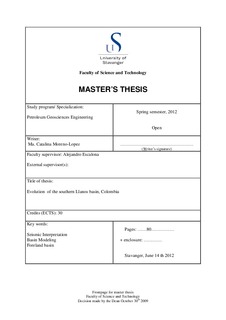| dc.contributor.author | Moreno-Lopez, Maria Catalina | |
| dc.date.accessioned | 2012-11-26T10:00:47Z | |
| dc.date.available | 2012-11-26T10:00:47Z | |
| dc.date.issued | 2012 | |
| dc.identifier.uri | http://hdl.handle.net/11250/183474 | |
| dc.description | Master's thesis in Petroleum Geosciences engineering | no_NO |
| dc.description.abstract | The Llanos basin, located in the eastern region of Colombia, South America, is a foreland basin between the Eastern Cordillera (Colombian Andes) and the Guyana Precambrian shield. This Andean foreland basin is the latest stage of a complex Paleozoic- recent multiphase evolution of eastern Colombia, where previous tectonic phases have been overprinted but still can be identified in the southern part of the Llanos basin.
Using ~5000 km of 2D seismic data and 19 exploratory wells in the southern Llanos basin, the tectono- stratigraphic evolution was analyzed in order to better understand the different structural styles and timing of deformation of the pre-foreland structures that can define new trends in exploration.
Four main tectono-sequences divided by regional unconformities were identified: a)Lower Paleozoic, b) Upper Paleozoic and c) Upper Cretaceous and d) Cenozoic.
a) The fold and thrust belt of Neo- proterozoic rocks and Paleozoic triangular zones are the result of a compressional event during the Lower Paleozoic; b) Upper Paleozoic sediments were deposited in piggy back basin at top of the thrusting. The rocks are mainly black graptholitic shales (Upper Paleozoic). This sequence has high potential as source rock and hydrocarbon generation.
A major sequence boundary is interpreted between folded Paleozoic rocks and overlying Upper Cretaceous-Paleocene wedge. c) Upper Cretaceous –Paleocene consists of shallow marine sediments deposited in the distal area of the Cretaceous foreland basin; and d) Cenozoic sequence dominated by fluvial-deltaic sedimentary rocks that were deposited in Llanos foreland basin. The basin was formed during uplift of the Eastern Cordillera from Late Paleogene to Recent.
As result, several types of traps were developed, which include: Cenozoic thrusts related with the uplift of the Eastern Cordillera, normal faults on the foredeep hinge areas, Cretaceous stratigraphic traps and Piggy-back basins formed by the the reactivation of the Lower Paleozoic/Neoproterozoic? fold and thrust belt.
Paleozoic piggy back basins represent a new exploration target that have been poorly explored in comparison to the better understood and explored plays in the Eastern Cordillera foothills and the flexural normal faults in the present-day foredeep area. | no_NO |
| dc.language.iso | eng | no_NO |
| dc.publisher | University of Stavanger, Norway | no_NO |
| dc.relation.ispartofseries | Masteroppgave/UIS-TN-IPT/2012; | |
| dc.subject | petroleumsteknologi | no_NO |
| dc.subject | seismic interpretation | no_NO |
| dc.subject | foreland basin | no_NO |
| dc.subject | petroleumsgeologi | no_NO |
| dc.title | Evolution of the southern Llanos basin | no_NO |
| dc.type | Master thesis | no_NO |
| dc.subject.nsi | VDP::Technology: 500::Rock and petroleum disciplines: 510::Petroleum engineering: 512 | no_NO |
